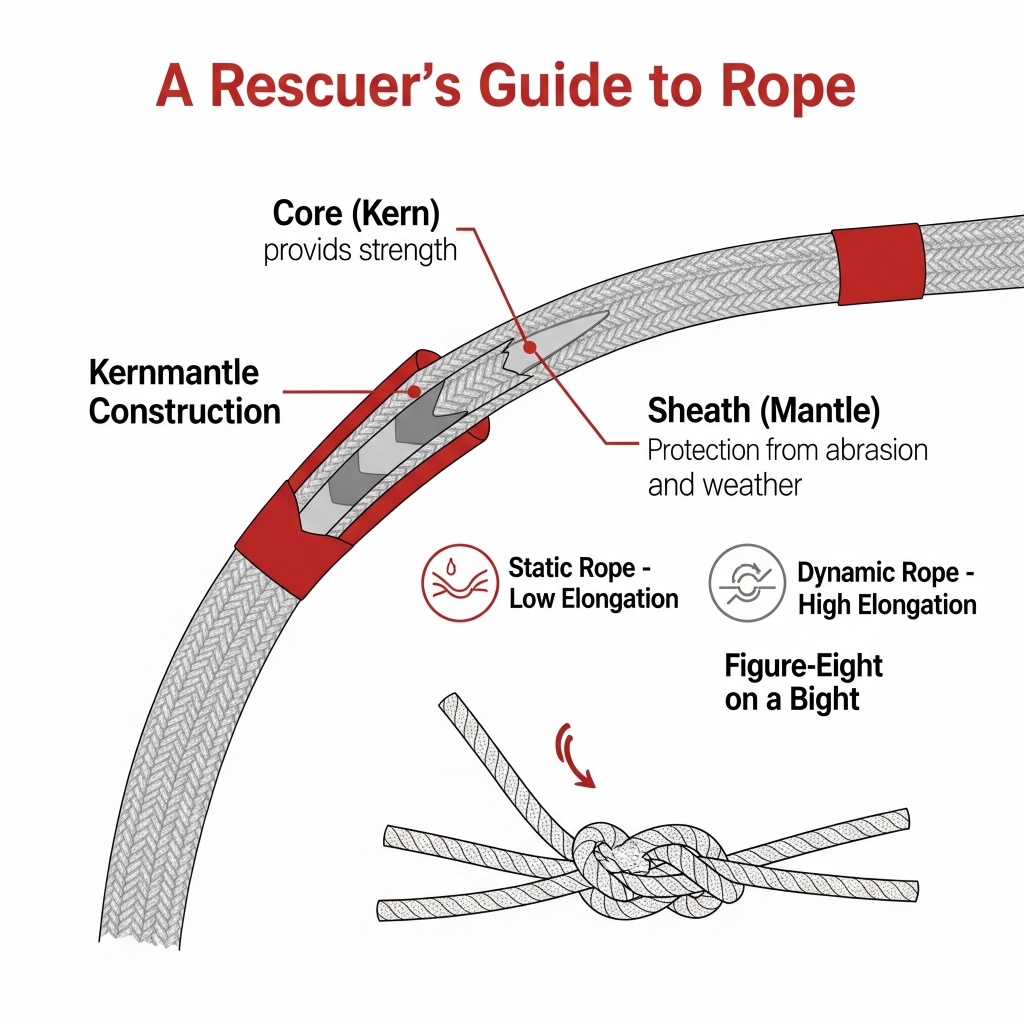
As someone who’s spent years in the field, I’ve seen firsthand the critical role that rescue ropes play in saving lives. In this comprehensive guide, I’ll walk you through Rescue Rope 101 – from essential equipment to key rules that could mean the difference between success and failure in a rescue mission.
When it comes to rescue operations, having a solid understanding of rescue ropes is non-negotiable. Whether you’re a seasoned professional or a beginner looking to delve into the world of rope rescue, this guide will equip you with the knowledge and skills needed to navigate any rescue scenario with confidence.
Join me as I break down the fundamental principles of rescue ropes and provide you with practical tips and rules to ensure that you’re prepared for whatever challenges come your way.
Key Takeaways
- Rescue ropes are vital: They play a crucial role in saving lives during emergencies, providing stability, support, and safe transportation in challenging situations.
- Choose the right equipment: Essential gear such as dynamic ropes, harnesses, carabiners, and pulleys are crucial for successful rope rescue missions.
- Follow key rules: Prioritize safety, practice clear communication, continuous training, proper equipment inspection, teamwork, and adaptability for effective rope rescue operations.
- Preparation is key: Regular training, clear communication, safety prioritization, equipment inspections, teamwork, adaptability, following protocols, and staying calm are essential for successful rope rescue missions.
A Rescuer’s Guide to Rope
In technical rescue, a rope is not just a rope; it’s a lifeline. Rescue ropes are highly engineered pieces of equipment designed for reliability under extreme conditions. Understanding their construction, types, and proper use is critical for safety.

Key Concepts for Rescue Ropes:
Kernmantle Construction: Modern rescue ropes use a kernmantle design.
Kern (Core): This is the internal core of the rope and provides the majority of its tensile strength (up to 90%). It consists of parallel or braided fibers that run the entire length of the rope.
Mantle (Sheath): This is the woven outer sheath that protects the core from abrasion, UV light, and dirt. It also gives the rope its color and handling characteristics.
Types of Rope (Static vs. Dynamic):
Static Rope: This is the primary type used for rescue and rigging. It has very low elongation (stretch), typically stretching only 2-5% under a working load. This is crucial because it prevents a bouncing effect, providing a stable line for hauling, lowering, or rappelling with a person or equipment.
Dynamic Rope: This type is designed to stretch significantly (up to 40%) to absorb the energy of a fall. It is used almost exclusively for recreational rock climbing where a leader might fall. It is unsuitable for most technical rescue scenarios because the stretch would make controlled raising or lowering nearly impossible.
Essential Knots: Knowing how to tie secure, reliable knots that are easy to inspect and untie after being loaded is fundamental. The Figure-Eight family of knots is the foundation of rescue rigging. The “Figure-Eight on a Bight,” shown in the image, creates a strong, fixed loop at the end of a rope that can be easily attached to an anchor or a harness with a carabiner.
Importance of Rescue Ropes in Saving Lives
Rescue ropes play a crucial role in saving lives during emergency situations. Statistics have shown that having the right rescue rope at the right time can significantly increase the chances of a successful rescue operation.
In critical scenarios such as building collapses, mountain rescues, or swiftwater incidents, a reliable rescue rope can be the difference between life and death. When used correctly, rescue ropes provide stability, support, and a means of safe transportation in challenging environments.
As a rope rescue professional, understanding the importance of choosing the right rescue rope for each situation is paramount. Factors such as rope length, diameter, material, and strength capacity should be carefully considered to ensure optimal performance when faced with various rescue scenarios.
Having a solid grasp of the fundamental principles of rope rescue, including anchoring techniques, load distribution, and proper knot tying, is essential for executing successful rescue missions. By adhering to safety protocols and industry best practices, rescue teams can minimize risks and maximize efficiency when using rescue ropes.
Essential Equipment for Rope Rescue
When it comes to rope rescue missions, having the right equipment is non-negotiable. Here are some essential pieces of gear that are crucial for a successful operation:
- Rope: The backbone of any rescue operation, choose a dynamic rope for its ability to stretch and absorb energy, reducing the impact force on the rescuer and the victim.
- Harness: A well-fitted harness is essential for safety and comfort during rope rescues. Look for one with padded leg loops to prevent discomfort during prolonged hanging.
- Carabiners: These heavy-duty connectors are used to link various components of the rescue system. Opt for locking carabiners to ensure they stay securely closed.
- Pulleys: Essential for mechanical advantage systems, pulleys reduce the amount of force needed to lift a victim. Choose pulleys that are strong and efficient for smoother operations.
Key Rules for Effective Rope Rescue Operations
When it comes to rope rescue operations, following key rules is crucial for ensuring safe and successful outcomes. In my experience, abiding by these rules can make a significant difference in the efficiency and effectiveness of rescue missions.
- Safety First: Prioritize safety above all else. Conduct thorough risk assessments, use proper safety equipment, and always have a backup plan in place.
- Clear Communication: Effective communication is essential. Use clear and concise verbal and non-verbal cues to ensure smooth coordination among team members.
- Continuous Training: Regular training sessions are vital to keep skills sharp and stay updated on the latest techniques and equipment advancements.
- Proper Equipment Inspection: Before every mission, inspect all rescue gear meticulously. Ensure everything is in top condition and replace any damaged or worn-out equipment.
- Teamwork: Rope rescue operations require excellent teamwork. Trust your team members, delegate tasks effectively, and work together seamlessly to achieve the best results.
- Adaptability: Be prepared to adapt to changing situations quickly. Flexibility and the ability to think on your feet are key qualities for successful rope rescue operations.
By adhering to these key rules, rope rescue operations can be carried out with precision, safety, and efficiency. Remember, preparation and adherence to best practices are foundational to successful rescue missions.
Tips for Successful Rope Rescue Missions
When it comes to rope rescue missions, preparation is key. Here are some essential tips to ensure successful operations:
- Regular Training: I can’t stress this enough – ongoing training is crucial for maintaining skills and readiness.
- Clear Communication: Communication is vital during rescue missions to ensure everyone is on the same page.
- Safety First: Always prioritize safety above all else. It’s non-negotiable.
- Inspect Equipment: Before every mission, check all equipment thoroughly to ensure it’s in proper working condition.
- Teamwork: Rope rescue missions are a team effort. Trust your team and work together seamlessly.
- Adaptability: Stay flexible and be prepared to adjust plans based on the situation at hand.
- Follow Protocols: Stick to established protocols and procedures to maintain consistency and efficiency.
- Stay Calm: In high-pressure situations, it’s crucial to stay calm and focused to make sound decisions.
Conclusion
In wrapping up this Rescue Rope 101 guide, remember that proper training, communication, safety measures, equipment checks, teamwork, adaptability, protocol adherence, and maintaining composure are key elements for successful rope rescue missions. By incorporating these crucial tips into your rescue operations, you can significantly increase the safety and effectiveness of your team. Stay focused, stay prepared, and always prioritize safety above all else. With the right knowledge and skills, you can handle any rope rescue situation with confidence and precision. Keep practicing, keep learning, and keep honing your rescue rope techniques to ensure the best outcomes in every mission.
Frequently Asked Questions
What are the essential tips for successful rope rescue missions?
Successful rope rescue missions require regular training, clear communication, prioritizing safety, equipment inspection, teamwork, adaptability, following protocols, and staying calm under pressure.
Why are these tips important for rope rescue missions?
Implementing these tips enhances safety, ensures preparedness, promotes effective communication, and emphasizes adherence to established procedures, leading to successful rescue missions.
